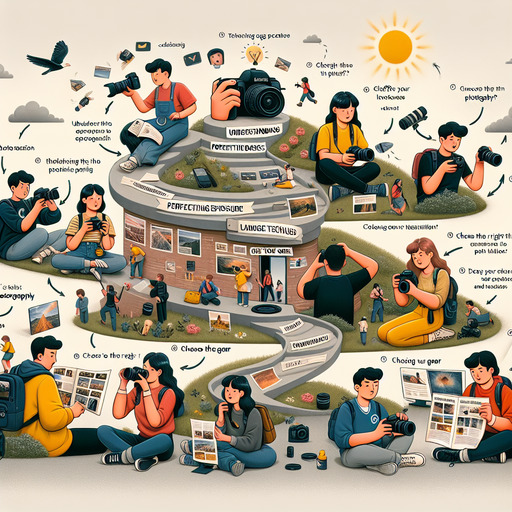
-
Table of Contents
- Mastering Photography: Tips and Techniques for Stunning Shots
- Understanding the Basics of Photography
- Exposure: The Key to Perfect Shots
- Composition: Crafting the Perfect Frame
- Advanced Photography Techniques
- Portrait Photography: Capturing Emotions
- Landscape Photography: Embracing Nature’s Beauty
- Editing: Enhancing Your Images
- Basic Editing Techniques
- Choosing the Right Photography Gear
- Cameras and Lenses
- Conclusion
- Questions and Answers
Mastering Photography: Tips and Techniques for Stunning Shots
Photography is more than just capturing moments; it’s about telling stories through images. Whether you’re a budding photographer or a seasoned professional, understanding the nuances of photography can elevate your work to new heights. In this guide, we’ll explore essential photography tips, techniques, and insights to help you capture breathtaking images.
Understanding the Basics of Photography
Before diving into advanced techniques, it’s crucial to grasp the fundamentals of photography. These basics form the foundation upon which all great photography is built.
Exposure: The Key to Perfect Shots
Exposure is the amount of light that reaches your camera sensor, and it significantly impacts the quality of your photos. It consists of three elements:
- Aperture: Controls the depth of field. A wider aperture (lower f-stop) creates a shallow depth of field, perfect for portraits.
- Shutter Speed: Determines how long the camera’s shutter remains open. Faster speeds freeze motion, while slower speeds capture movement.
- ISO: Adjusts the camera’s sensitivity to light. Higher ISO settings are useful in low-light conditions but can introduce noise.
Composition: Crafting the Perfect Frame
Composition is about arranging elements within your frame to create a visually appealing image. Consider these techniques:
- Rule of Thirds: Divide your frame into thirds, both horizontally and vertically, and place key elements along these lines.
- Leading Lines: Use natural lines to guide the viewer’s eye through the image.
- Symmetry and Patterns: Incorporate symmetry or repetitive patterns for a balanced composition.
Advanced Photography Techniques
Once you’ve mastered the basics, it’s time to explore advanced techniques that can add depth and creativity to your photography.
Portrait Photography: Capturing Emotions
Portrait photography is about capturing the essence of a person. Here are some tips to enhance your portraits:
- Lighting: Use natural light for soft, flattering portraits. Experiment with different lighting angles to create mood.
- Background: Keep the background simple to focus attention on the subject.
- Interaction: Engage with your subject to capture genuine expressions.
Landscape Photography: Embracing Nature’s Beauty
Landscape photography allows you to showcase the beauty of the natural world. Consider these strategies:
- Golden Hour: Shoot during the golden hour (shortly after sunrise or before sunset) for warm, soft lighting.
- Foreground Interest: Include elements in the foreground to add depth to your images.
- Weather Conditions: Embrace different weather conditions for unique and dramatic shots.
Editing: Enhancing Your Images
Post-processing is an essential part of modern photography. It allows you to refine and enhance your images.
Basic Editing Techniques
Start with these basic editing techniques to improve your photos:
- Crop and Straighten: Adjust the composition and alignment of your images.
- Adjust Exposure: Fine-tune the brightness and contrast for a balanced look.
- Color Correction: Ensure accurate colors by adjusting white balance and saturation.
Choosing the Right Photography Gear
Your choice of gear can significantly impact your photography. Here’s what to consider:
Cameras and Lenses
Invest in a camera and lenses that suit your photography style. For example:
- DSLRs and Mirrorless Cameras: Offer versatility and high image quality.
- Prime Lenses: Provide sharpness and wide apertures for low-light conditions.
- Zoom Lenses: Offer flexibility for various shooting scenarios.
Conclusion
Photography is a journey of continuous learning and exploration. By mastering the basics, experimenting with advanced techniques, and choosing the right gear, you can capture stunning images that tell compelling stories. Remember, practice and creativity are your best allies in this artistic endeavor.
For more in-depth information on photography techniques, you can visit Wikipedia’s Photography Page.
Questions and Answers
Q1: What is the best time of day for landscape photography?
A1: The best time for landscape photography is during the golden hour, which occurs shortly after sunrise and before sunset. The lighting is soft and warm, creating beautiful, natural colors.
Q2: How can I improve my portrait photography skills?
A2: To improve your portrait photography, focus on lighting, engage with your subject for genuine expressions, and keep the background simple to highlight the subject.
Q3: What is the importance of post-processing in photography?
A3: Post-processing is crucial for refining and enhancing your images. It allows you to adjust exposure, correct colors, and crop images to improve composition.
If you’re interested in learning more about photography or our services, please contact us for more information.